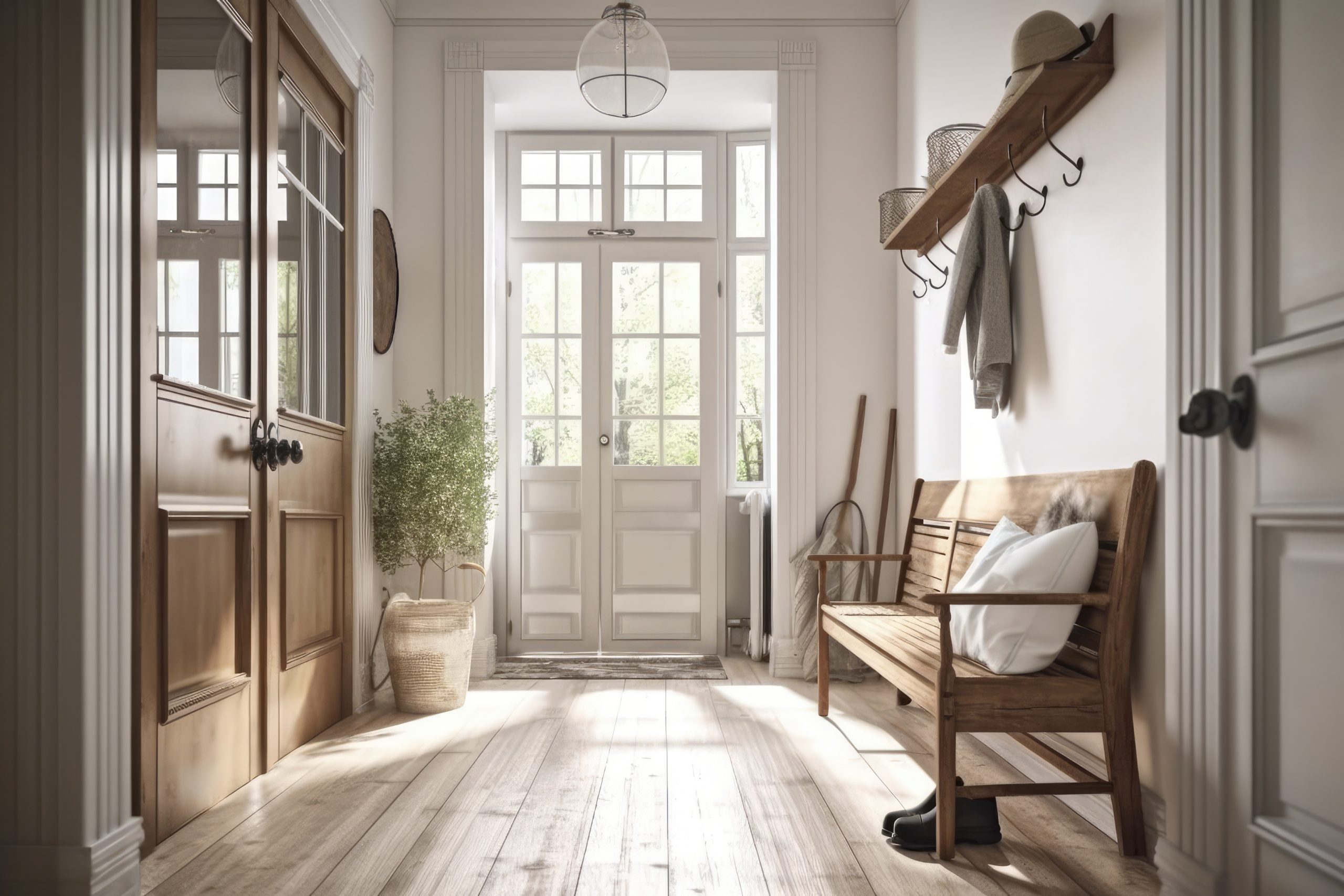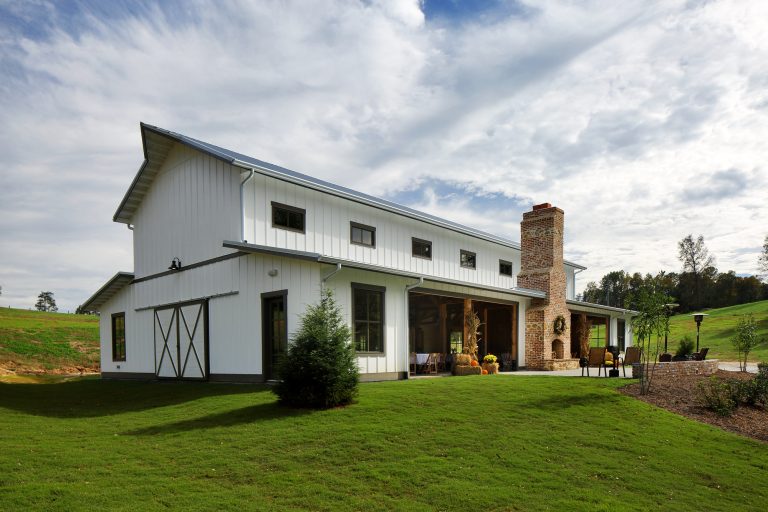Farmhouse homes have always held a distinctive allure. Rooted in history, these homes encapsulate the essence of a simpler time, offering a sense of comfort and nostalgia. As architectural designs evolve, homeowners often face the intricate task of preserving that authentic rustic charm while infusing modern comforts.
Successfully navigating this design landscape provides the ultimate reward: a home that seamlessly weaves the warm traditions of the past with the conveniences of today. The journey to achieve this balance can be intricate, but the end result is a living space that is both timeless and contemporary, a testament to the power of thoughtful design.
Historical Context Of Farmhouse Design
The farmhouse style originated from the need for practical and functional homes suited to agrarian life. These dwellings were built with materials readily available in the region, often wood or stone, lending them a strong connection to the surrounding landscape. Over time, as agricultural practices evolved and regions developed, so too did the design of these homes. They began to incorporate features addressing the unique challenges faced by farming families, such as mudrooms for dirty boots or large kitchens for preparing hearty meals.

A defining characteristic of early farmhouse designs was the incorporation of rustic elements. Exposed beams, handcrafted furnishings, and wide plank floors were not just stylistic choices but were borne out of necessity and utility. These features, rooted in function, have become emblematic of the farmhouse style. They serve as enduring reminders of the homes’ ties to the land and the daily lives of those who once inhabited them.
Key Elements Of Rustic Charm
The authentic charm of farmhouse homes is deeply anchored in their rustic elements. Recognizing and incorporating these elements ensures the preservation of the traditional ambiance while allowing room for modern enhancements.
- Natural Materials
Central to the rustic aesthetic is the use of natural materials. Among these, wood stands out. Different wood varieties, such as oak, pine, and cedar, each bring unique textures and grains, playing specific roles in the construction and design.
Oak, known for its durability and rich color, often graces floors and cabinetry. Pine, with its distinct knots and lighter hues, is ideal for walls and ceilings. Cedar, appreciated for its aromatic qualities, is a top choice for closets and chests.
Equally significant is stone. This robust material has historically been employed for foundations, walls, and fireplaces. Varieties range from smooth river rocks to rough-hewn granite, each contributing differently to the overall aesthetic. While river rocks might be used for a decorative facade or pathway, granite could lend solidity to kitchen counters or backsplashes.
- Vintage Furniture
Introducing vintage furniture into farmhouse homes serves two purposes. Firstly, it continues the narrative of history and heritage. Secondly, it adds undeniable character to the interiors. Sourcing such furniture requires visiting antique shops, local auctions, or even garage sales.
Authenticity is key. Look for pieces that have stories behind them, which often means signs of wear or age. When selecting, ensure the pieces resonate with the existing decor. A vintage wooden table, for instance, could be paired with contemporary chairs, blending history with the present. Integration, then, is not just about placement but ensuring harmony between old and new.
- Color Palettes
The color palette in farmhouse designs traditionally leans toward earthy tones. These hues—beiges, browns, soft greens, and muted blues—are evocative of nature and the outdoors. However, in achieving a balanced design, one can complement these with modern hues. For example, a deep charcoal or a subtle metallic accent can provide a contemporary touch without overwhelming the rustic base.
The trick is to use these colors sparingly and strategically. Maybe a modern art piece on a traditionally colored wall or a sleek light fixture against a wooden ceiling. By merging these palettes, the design retains its rustic roots while nodding to the contemporary.
Understanding and adeptly using these elements is vital for anyone seeking to authentically capture the farmhouse aesthetic. It’s a dance of tradition and innovation, where each step is taken with respect to the past and an eye to the present. For more insights and guidance on achieving this balance in home designs, visiting https://www.jabconst.com/ offers a wealth of resources and expertise.
Modern Comforts To Integrate
In the realm of farmhouse design, tradition often takes center stage. However, introducing modern comforts can elevate these homes’ functionality without diminishing their charm. Modernity, when integrated thoughtfully, complements rustic aesthetics, providing homeowners with the best of both worlds.
- Contemporary Kitchen Appliances
Kitchens, historically the heart of the farmhouse, have seen significant advancements in recent years. Contemporary kitchen appliances, from induction cooktops to smart refrigerators, play a pivotal role in enhancing efficiency and convenience.
For instance, a modern oven with precise temperature controls ensures that dishes are cooked perfectly, enhancing culinary experiences. Likewise, advanced refrigerators, with features such as adjustable compartments and optimal temperature regulation, contribute to food preservation and reduced waste.
Integrating these appliances in designs that match the rustic environment is essential. Using finishes like brushed steel or matte black permits technological advancement without disrupting the aesthetic flow.
For a farmhouse, maintaining optimal indoor temperatures is paramount, given their often-expansive spaces. Modern heating and cooling systems, specifically tailored to these homes, guarantee comfort throughout the year.
Radiant floor heating, for instance, provides consistent warmth during colder months, eliminating cold spots prevalent in older homes. On the flip side, energy-efficient cooling systems, like ductless mini-splits, offer targeted cooling, ensuring rooms remain at desired temperatures without excessive energy consumption.
- Smart Home Technology
As technology evolves, smart home elements have become indispensable for many homeowners. Within a farmhouse setting, certain smart features align perfectly. Smart thermostats, for example, allow homeowners to adjust temperatures remotely, optimizing energy use based on their schedules.
Additionally, smart lighting solutions can be employed to create ambiance, transitioning from bright task lighting to softer mood lighting with the touch of a button or voice command. Lastly, security systems, from smart locks to surveillance cameras, ensure safety while remaining unobtrusive in design.
Incorporating modern comforts into farmhouse homes is not about abandoning tradition but enhancing it. It’s about ensuring these homes remain relevant, functional, and efficient in today’s world, providing residents with an enriched living experience.
Strategies For A Harmonious Blend
Achieving a balance in farmhouse homes requires deliberate choices that respect the inherent charm while weaving in modern elements. Several strategies can ensure this blend is both beautiful and functional.
- Dual-Purpose Pieces
Investing in furniture that serves multiple purposes is an effective approach. Consider a vintage-inspired dining table with hidden storage compartments or a rustic bench that doubles as a bookshelf.
These dual-purpose pieces not only save space but also integrate modern utility within traditional design frameworks. The goal is to find or commission items that respect the farmhouse’s heritage but also cater to contemporary living needs.
- Modern Textiles
Modern textiles can bring a refreshing touch to traditional spaces. When selecting fabrics for upholstery, curtains, or rugs, opt for those that echo the patterns and textures of classic farmhouse designs.
For instance, a geometric print might evoke traditional quilt patterns, while a minimalist fabric could subtly complement wooden furniture or stone surfaces. The key is to choose textiles that feel current yet don’t clash with the home’s foundational design elements.
- Floor Plans
The layout of a farmhouse plays a significant role in its overall ambiance. While maintaining the essence of original designs, consider subtle modifications to better fit modern lifestyles. Maybe it’s about creating an open-plan kitchen and living area for family gatherings or adding an en-suite bathroom to a bedroom for added privacy.
When making these changes, it’s essential to ensure that they don’t detract from the home’s core character. Retaining features like exposed beams or original woodwork can help anchor these modifications in the farmhouse tradition.
The journey to balance rustic charm with modern comfort is an exercise in respect and innovation. By employing these strategies, homeowners can craft spaces that celebrate the past while embracing the present.
Benefits Of This Balance
Marrying rustic elements with modern comforts offers several advantages. First, the visual interplay of both styles results in unique, captivating interiors, creating a distinctive aesthetic appeal. Such interiors are not merely about looks; they combine the best of both worlds. The fusion ensures spaces are not just rich in character but also brim with the conveniences of contemporary living.
Moreover, this blend has a tangible impact on property valuation. Homes that skillfully combine tradition with modernity often command a higher market value. Prospective buyers see value in a property that offers the warmth of a classic farmhouse while catering to today’s lifestyle needs.
Conclusion
Achieving the ideal equilibrium between rustic charm and modern comforts in farmhouse homes brings immense satisfaction. It represents a design journey where homeowners navigate the intricacies of melding the past with the present. As architectural trends evolve, this pursuit remains a dynamic endeavor. Every decision, every blend, enriches the tapestry of home design, ensuring that as times change, the essence of the farmhouse continues to resonate, adapt, and thrive.

